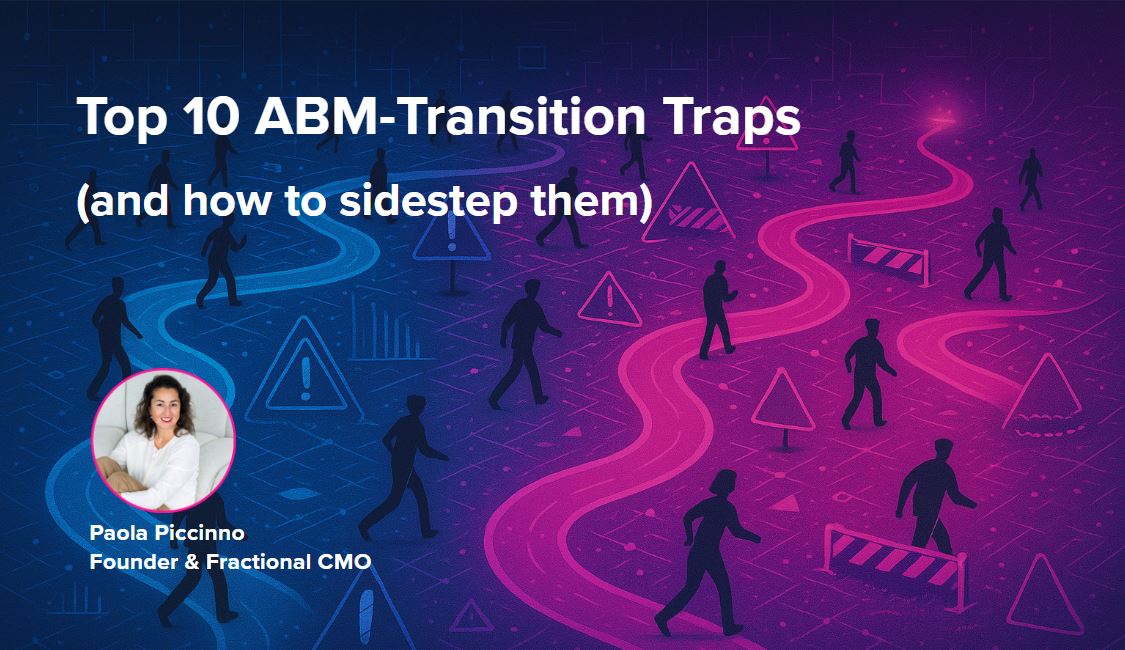Top 10 ABM-Transition Traps (and how to sidestep them)

Shifting to account-based marketing (ABM) isn’t just a marketing tactic—it’s a strategic transformation that requires organizational alignment, the right tools, and a fresh mindset. In a recent session with ABM expert and fractional CMO Paola Piccinno, we unpacked the ten most common pitfalls that companies face during the transition to ABM—and how to avoid them. Whether you’re piloting your first ABM program or scaling it across teams, this is your roadmap to doing it right.
1. Building the Wrong (or Bloated) Target-Account List
ABM starts with focus—and that means curating the right list. Too often, sales dictates the account list without validation. We discussed the importance of a rigorous account selection process that aligns with business objectives and leverages real data and internal insights. Don’t skip this foundational step—your ABM success depends on it.
2. Keeping Sales & Marketing in Their Old Silos
ABM thrives on alignment, but legacy habits die hard. Sales and marketing must move from parallel tracks to a shared go-to-market motion. Early-stage collaboration, joint training sessions, and shared KPIs can help bridge the gap. As Paola puts it, ABM is as much about change management as it is about strategy.
3. Lack of Executive Sponsorship
Without top-down support, ABM won’t stick. Executive champions help secure budget, break down barriers, and reinforce cross-functional buy-in. If leadership isn’t on board yet, start small with a pilot and showcase early wins to build momentum.
4. Measuring with Lead-Centric KPIs
Stuck on MQLs and open rates? ABM demands a new scorecard—think engagement, pipeline progression, and account-level outcomes. Adopt the “three Rs”: Reputation, Relationships, and Revenue. Quarterly KPI reviews help ensure you’re tracking what truly matters.
5. Under-Investing in Data Quality & Intent Signals
ABM without insights is like flying blind. You don’t need fancy tools from day one, but you do need high-quality data. Start with what you have—sales notes, customer success insights, even LinkedIn profiles—and layer in intent signals as you mature. ABM is a data-first strategy.
6. One-Size-Fits-All “Personalization”
Personalization is not just about placing a company’s logo on a landing page. True ABM means contextual, persona-driven messaging—especially at the one-to-one or one-to-few level. That’s where ROI is highest. Treat your audience like real people, not just names on a list.
7. Overcomplicating (or Under-Integrating) the Tech Stack
Don’t fall into the trap of buying tech before building strategy. You can start ABM with minimal tools. Success stems from alignment, not automation. Choose tech that supports your goals—not the other way around.
8. Assigning ABM to “Spare-Time” Resources
ABM requires ownership. It’s not a side project. Assign a dedicated resource—or at minimum, clear ownership—to drive the program internally. Without it, momentum stalls and the program risks fading into “just another campaign.”
9. Relying on a Single Channel
ABM is not a LinkedIn campaign. It’s a coordinated, multichannel effort across digital, direct mail, events, sales outreach, and more. The power is in the orchestration. If you’re only using one channel, you’re not doing ABM.
10. Expecting Quick, Campaign-Length Wins
ABM is a long game. Results don’t show up overnight. Set expectations accordingly—at least six months for meaningful outcomes. Start with early indicators, track against short-, mid-, and long-term KPIs, and be ready to iterate.
💡 Final Thought
If you’re serious about ABM, sidestep these traps by treating it as a strategic, cross-functional initiative—not a marketing trend. As Paola shared, done right, ABM is a goldmine.
👉 Watch the full webinar below to dive deeper into each of these ten traps and hear real-world examples and strategies from the frontlines.
